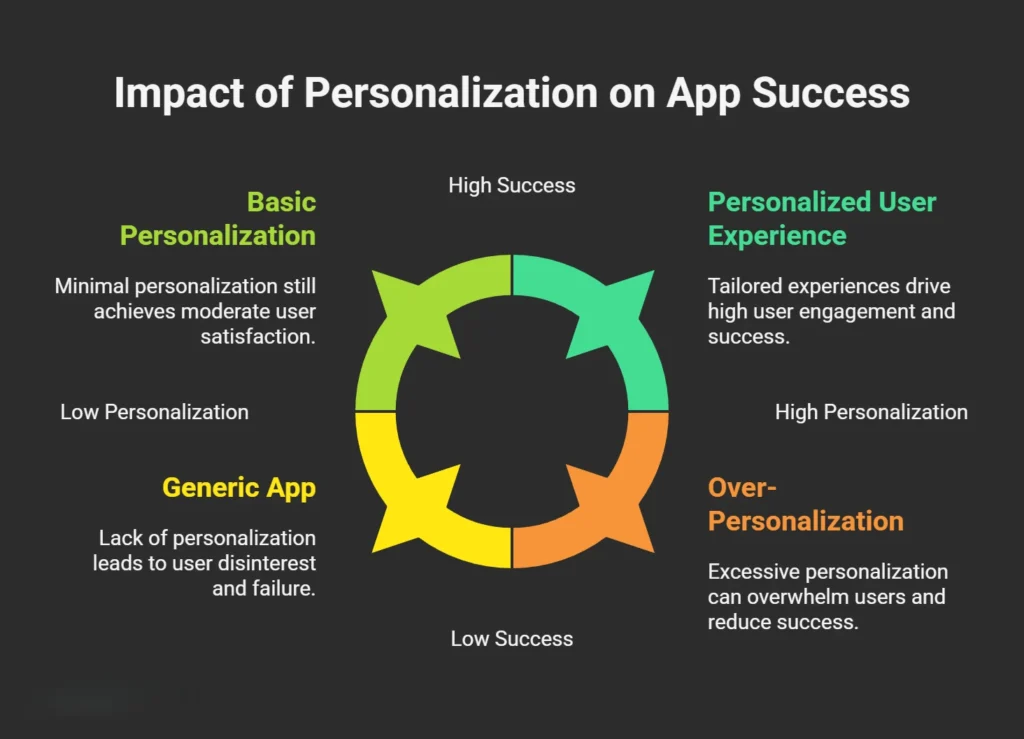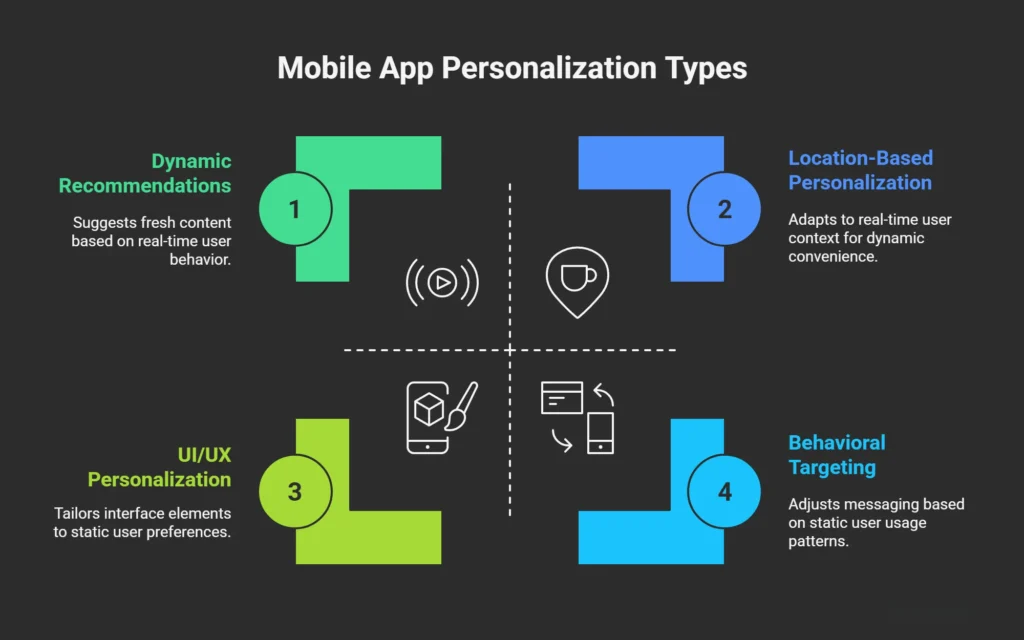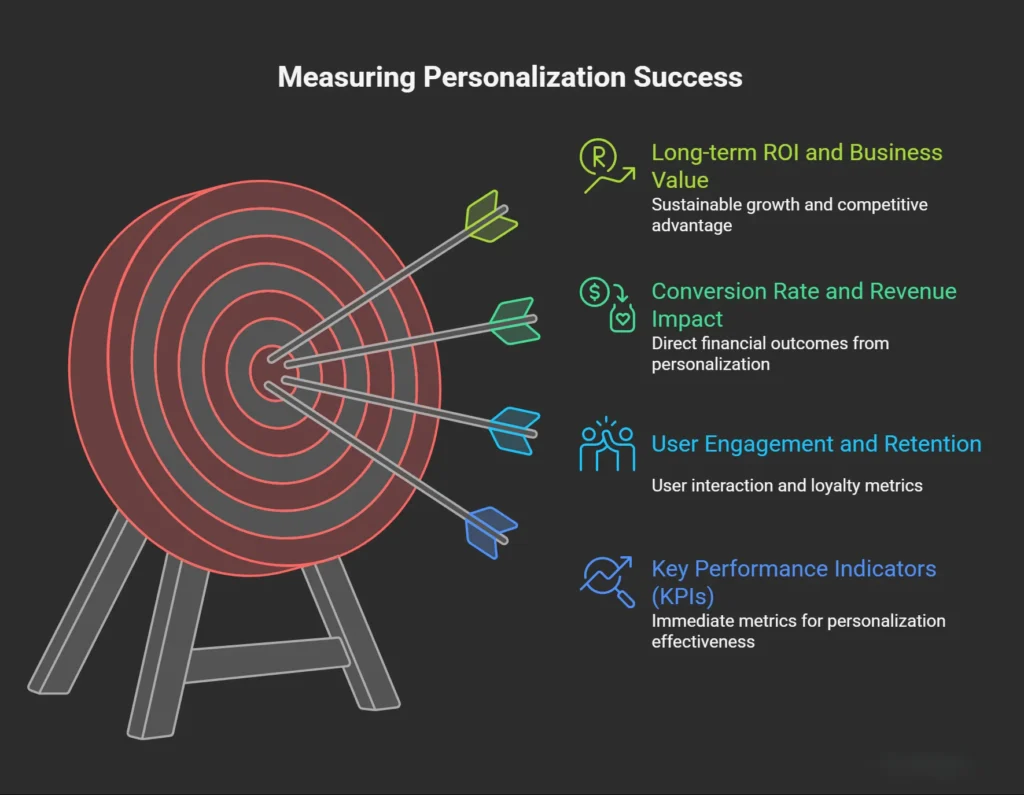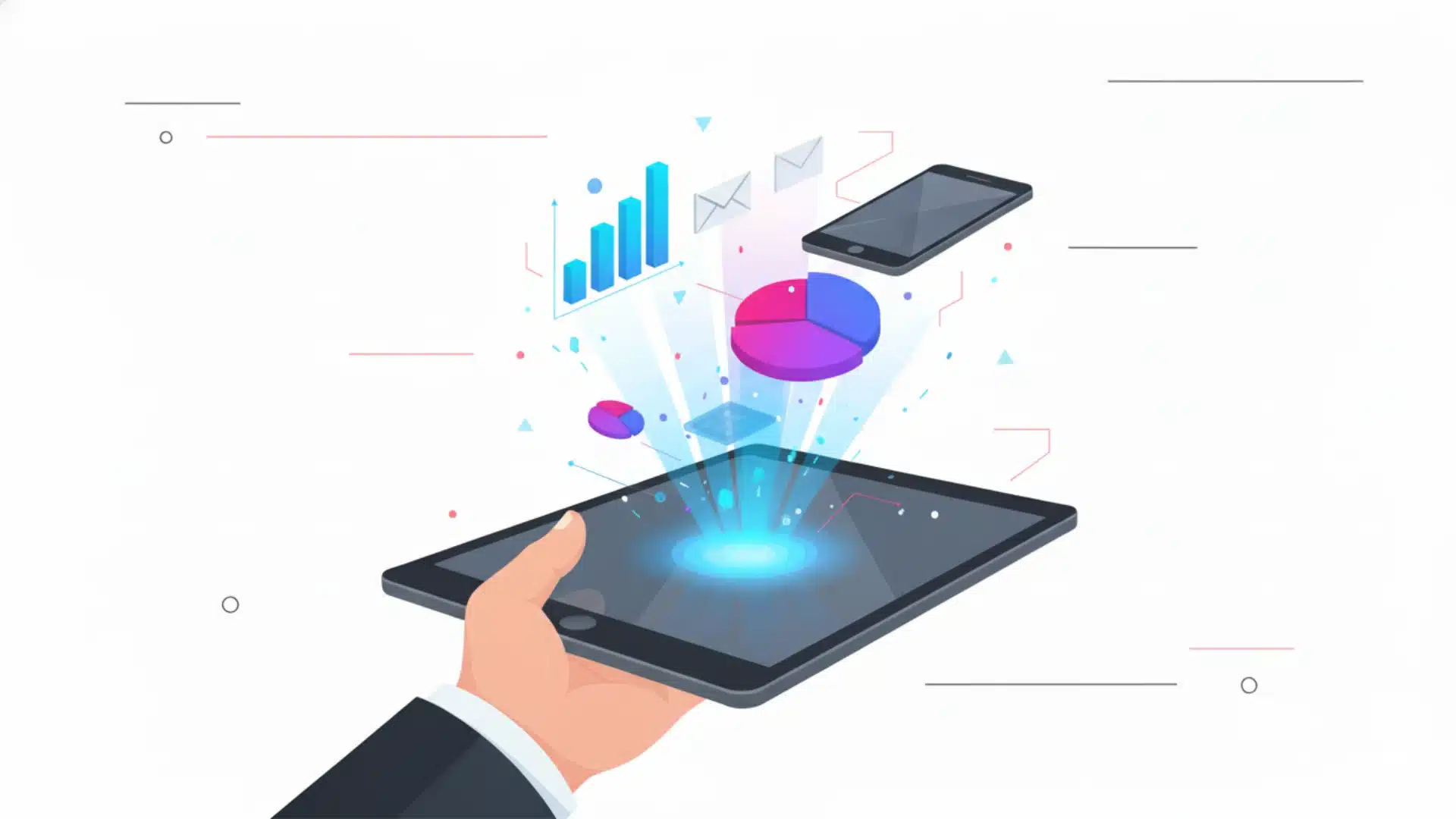Mobile app personalization is one of such things that shape how users feel when they open your app, i.e –
- Welcome,
- Understood, and
- In control.
It’s what turns casual users into daily loyalists. If your app still treats everyone the same, you’re already behind.
Most Founders and CXOs don’t need fancy dashboards or complexity, no, they need results. That means giving users what they actually want, when they want it, without friction.
That is why, in this guide, we’ll walk through how mobile app personalization works in 2025, what’s driving the shift, and how to stay ahead. So, without wasting much time, let’s jump straight into it.
What is Mobile App Personalization?
Mobile app personalization is about shaping your app to respond like it truly knows your users, what they like, what they ignore, and when they’re most likely to act.
For a founder or CMO, this isn’t some optional UX tweak. It’s the difference between an app people open once and one they rely on daily.
Moreover, if done right, personalization drives habits. Think dynamic content, contextual offers, personalized onboarding, or even predictive nudges that simplify decisions. It’s not just the user interface, it’s the entire user journey being built to mirror each individual’s behavior, intent, and preference.
For instance:
- A Epsilon study says that 80% of consumers are more likely to purchase from a brand that offers personalized experiences.
Therefore, personalization should be integrated into your strategic app launch approach to maximize user adoption and engagement from day one.
Why Mobile App Personalization Matters in 2025

In 2025, users are expecting. Mobile app personalization has moved from being a feature to a fundamental one. If your app still treats everyone the same, chances are it’s being uninstalled or forgotten.
Let’s explore how personalization shapes outcomes across the board.
- User Expectations and Market Demands
Today’s users want apps that feel like they understand them from the first tap. Personalization in 2025 must go beyond surface-level tweaks. It’s about making every screen, suggestion, and journey feel intentional. Moreover, failing to do so often leads to quiet exits and negative app reviews.
- Impact on User Engagement and Retention
When your app knows what matters to the user, they stick around. Personalization adds relevance, and relevance builds habit. Mobile app personalization boosts retention by making people feel the app evolves with them, not just delivers static content every time they return.
- Revenue Growth and Business Benefits
Personalized flows turn engagement into revenue. Users are more likely to spend when the experience feels tailored. It reduces friction in upsells, increases lifetime value, and sharpens insights. In turn, this personalization helps optimize performance without relying on aggressive tactics.
- Competitive Advantage in Crowded Markets
Lastly, with thousands of apps launching daily, relevance is your edge. Mobile user experience personalization turns apps from generic to memorable. It’s how you stand out in a sea of sameness. By 2025, users expect more, and only those apps offering personalization will keep attention and trust.
Don’t believe us? 71% of users say they expect companies to deliver personalized interactions, as per McKinsey.
Types of Mobile App Personalization

Each user expects more than just a smooth app, they expect it to feel like it was made for them. That’s where different forms of mobile app personalization come into play, helping brands connect meaningfully across varied use cases.
- Content Personalization and Dynamic Recommendations
No two users scroll the same way. Tailoring content feeds or suggesting items based on past interactions creates a more meaningful app experience. Platforms like Netflix and Spotify thrive on this. In addition, dynamic recommendations use real-time behavior to keep suggestions fresh and relevant.
- UI/UX Personalization and Interface Adaptation
Secondly, sometimes personalization is not what’s shown, it’s how it’s shown. From font scaling and dark mode to personalized dashboards and tool placement, mobile app personalization improves accessibility and comfort by adapting UI/UX to user preferences.
- Behavioral Targeting and User Journey Optimization
Let’s say a user always skips the onboarding video. Smart apps learn this and adapt. Behavioral targeting mobile apps adjust messaging, features, or promotions based on usage patterns. Therefore, it’s about guiding each user down the path they’re most likely to follow.
- Location-Based and Contextual Personalization
Ordering coffee? Your app might surface the nearest café’s menu first. Apps that personalize based on GPS, time of day, weather, or even motion (e.g., walking vs. driving) offer more convenience by syncing with the user’s real-world context.
AI-Powered Personalization Technologies
Beneath the sleek interface of mobile apps lies a powerful engine of intelligence, AI. From recommendation algorithms to real-time decision-making, AI tools are redefining what mobile app personalization can achieve in 2025. Here’s how:
- Machine Learning and Predictive Analytics
Apps that anticipate rather than react create stickier experiences. Machine learning tracks patterns and predicts what users will want next, whether it’s an article, a product, or a feature. To be precise, it’s the brain that evolves with each tap, swipe, or scroll.
Stat: 91% of consumers are more likely to shop with brands that recognize, remember, and provide relevant offers.
- Natural Language Processing for Content Curation
Words matter. And NLP helps apps understand what users actually mean, not just what they type. From chat-based interfaces to personalized article feeds, NLP tools help in curating smarter, more context-aware content for every user.
- Computer Vision for Visual Personalization
Personalization isn’t limited to text or layout, visuals matter too. Computer vision enables apps to interpret photos, video, and surroundings to adapt visuals accordingly. From fashion to fitness, this AI-powered app personalization is helping to create highly tailored visual experiences.
- Real-Time Decision Engines and Recommendation Systems
This is where personalization gets truly intelligent. Real-time engines adjust app behavior on the fly. It changes product order, messaging, or layout based on live user input. Thus, it’s what keeps the app experience fresh, not formulaic.
Data Collection and User Segmentation
Understanding your users starts with the right data, but not just any data. Gathering meaningful insights and segmenting users smartly from the backbone of every winning mobile app personalization strategy.
Without it, even the smartest AI can’t deliver relevant experiences.
- Essential Data Types for Personalization
To personalize effectively, apps need more than names and email IDs. User preferences, interaction history, device usage, and in-app behavior are crucial.
Furthermore, apps also benefit from contextual data like time of day, location, or device type, helping shape truly relevant user journeys.
- Demographic, Behavioral, and Contextual Data
This trio forms the foundation of mobile app personalization. Demographics help group users by age, region, or gender. Additionally, behavioral data tracks habits, what they tap, skip, or search. Also, contextual signals like weather or device state refine the experience even further.
- Privacy-First Data Collection Strategies
With regulations tightening and users more privacy-conscious, mobile app personalization must now balance precision with respect. Therefore, use clear opt-ins, anonymized tracking, and transparent data usage. The goal is to personalize without ever feeling invasive, which builds lasting trust.
- Advanced Segmentation Techniques
Modern segmentation goes beyond basic demographics. Using AI-driven clustering, lookalike modeling, and intent prediction, apps can group users based on subtle behaviors. As a result, this helps serve hyper-specific journeys like sending different onboarding flows to similar users with distinct motivations.
Implementing Mobile App Personalization Strategy
A good idea means little without the right execution. Once your data is clean and segmented, it’s time to turn insight into action. This section outlines the key steps for rolling out a sustainable, scalable mobile app personalization plan.
- Setting Personalization Goals and KPIs
Before writing a single rule or script, define the “why.” What should personalization achieve, better retention, increased purchases, deeper sessions?
Map clear KPIs like conversion uplift, click-through rate, or session time. With clear goals, mobile app personalization becomes focused and measurable.
- Choosing the Right Personalization Framework
Secondly, frameworks differ based on app type, audience, and scale. Rule-based systems are simpler but lack flexibility. On the other side, AI-driven engines adapt in real-time. Moreover, some apps mix both. So, choosing wisely means aligning tech with your app’s complexity, update cycles, and desired outcomes.
- A/B Testing and Optimization Approaches
Even with smart systems, assumptions can fail. A/B testing helps you validate what really works. Try alternate headlines, layouts, timing, or call-to-actions. Additionally, focus on one variable at a time. Over time, personalized mobile app experiences get sharper by learning from real user responses.
- Cross-Platform Personalization Consistency
Users might start on mobile, continue on the web, and finish on tablet. Personalization has to feel seamless across all touchpoints. Therefore, syncing profiles, preferences, and behavioral cues across platforms ensures the user doesn’t feel like they’re starting over, no matter where they log in.
Personalization Features and Examples
To see real impact, it’s essential to explore how mobile app personalization plays out in the app experience itself. From the first tap to every repeat session, these features demonstrate personalization in action, driving engagement, retention, and user satisfaction.
- Push Notification Personalization
Firstly, push notifications work best when they feel like helpful nudges, not spam. Personalization helps apps send messages based on user behavior, time zones, and preferences. Whether it’s a gentle reminder to finish a task or a flash sale alert, relevance boosts open rates.
- Product Recommendation Engines
The backbone of mobile app personalization, product recommendations guide users to what they’re most likely to engage with or purchase. These engines analyze browsing patterns, previous purchases, and intent signals to surface relevant products. Thus, boosting conversions without feeling pushy.
- Onboarding Experience Customization
As we all know, first impressions matter. Personalized onboarding adapts flows based on user role, device type, or signup source. Instead of a one-size-fits-all tutorial, users see only what’s relevant. As a result, this helps them reach “wow!” moments faster and reduces early churn.
- Dynamic Content and Feed Personalization
Feeds that adjust in real-time based on user interest feel intuitive and addictive. Whether it’s a news app, video platform, or social feed, mobile app personalization ensures that each scroll delivers something fresh, interesting, and aligned with the user’s preferences. This ultimately increases session duration and interaction.
Industry-Specific Personalization Applications
Not all apps personalize in the same way. Different industries leverage mobile app personalization to serve distinct user needs. Here’s how personalization works in sector-specific contexts.
- E-commerce and Retail App Personalization
From personalized homepages to abandoned cart reminders, e-commerce apps use dynamic recommendations, location-aware offers, and loyalty-based segmentation to improve shopping journeys. Thus, personalized search and tailored discounts turn casual browsers into loyal customers with less friction.
- Entertainment and Media App Customization
In mobile app personalization, media platforms thrive by tailoring content suggestions. Streaming apps learn from watch history to offer curated playlists or suggested shows. Furthermore, news apps adjust feeds to match reading habits or regional trends. This ensures users stay engaged longer and revisit often.
- Financial Services and Banking Apps
Security and personalization coexist here. Finance apps personalize dashboards based on spending habits. Thus, offering insights tailored to financial goals and suggesting relevant services. Also, transaction alerts, investment nudges, and budget recommendations are fine-tuned to individual behavior and risk profiles.
- Healthcare and Fitness App Personalization
Lastly, wellness apps personalize everything from step goals to meal suggestions. Medical apps might adjust notifications based on medication routines or health conditions. Also, fitness platforms use workout history, biometrics, and user intent to build custom plans. As a result, this makes mobile app personalization crucial for habit formation and compliance.
Technical Implementation and Best Practices
Creating great mobile app personalization is not just about ideas, it’s also about how you execute them. Moreover, to fully leverage personalization, it’s essential to build a robust foundation with expert mobile app development services. Here are the things you need to take care of:
- Personalization Engine Architecture
A personalization engine acts as the brain behind tailored experiences. It pulls in user data, applies business logic, and returns the right content or recommendation. Moreover, the architecture typically includes data pipelines, processing layers, and decision engines that can function in real-time or asynchronously, depending on the app’s needs.
- Real-Time vs Batch Processing
Secondly, mobile app personalization can be delivered either instantly or on a schedule. Real-time processing is ideal for dynamic content and in-the-moment triggers, while batch processing is more suitable for daily digests or periodic updates. The right mix depends on user expectations, latency tolerance, and infrastructure readiness.
- API Integration and Third-Party Tools
Personalization often requires connecting with analytics platforms, CRM tools, and content engines. APIs enable seamless integration between the app and these third-party systems. Additionally, a modular, well-documented API setup assures faster implementation and easier maintenance across personalization workflows.
- Performance Optimization and Scalability
Last but not least, for effective mobile app personalization, speed and scale matter. Systems should handle millions of requests without lag. Techniques like edge caching, asynchronous processing, and load balancing help maintain app responsiveness while serving personalized content to diverse user segments efficiently.
Privacy, Security, and Compliance
Let’s now talk about privacy and security. Personalization requires data, but collecting and using it responsibly is non-negotiable. Also, the credibility of your mobile app personalization strategy depends on how well you protect user data. Here are some of the factors you need to follow.
- GDPR, CCPA, and Data Protection Regulations
Laws like GDPR and CCPA govern how user data is collected, stored, and used. For mobile app personalization, this means users must opt in before data is tracked, and they should be able to access or delete their data easily. These compliances also build trust and prevent legal issues.
- Transparent Data Usage and User Consent
Users are more likely to share data if they understand how it’s being used. So, displaying clear, concise consent forms and offering settings to control data sharing builds transparency. Letting users opt in to different levels of personalization enhances comfort without sacrificing engagement.
- Security Best Practices for User Data
It’s now time to learn about some best practices. Encrypt sensitive data both at rest and in transit. Use secure authentication protocols and keep systems updated against vulnerabilities. Role-based access and monitoring systems ensure that only the right people can access user data. Thus, reinforcing a secure environment for personalization systems.
- Building Trust Through Ethical Personalization
Lastly, mobile app personalization must balance relevance with respect. Avoid using sensitive attributes like health status or financial behavior unless explicitly permitted. Also, offer value in exchange for data like better recommendations or time savings, and avoid intrusive messaging.
Measuring Personalization Success

It’s not enough to implement personalization, you need to know it’s working. From engagement spikes to revenue gains, the right data tells the full story. Let’s look at how to measure the real impact of mobile app personalization.
- Key Performance Indicators (KPIs) for Personalization
Not all metrics are created equal. The most useful KPIs for personalization include click-through rates on personalized content, time spent on the app, and actions taken per session.
Also, tracking the right metrics through mobile app KPI tracking can also show what’s resonating and what’s not, giving product teams direction.
- User Engagement and Retention Metrics
Mobile app personalization should result in users sticking around longer. Track daily/monthly active users (DAU/MAU), session length, screen flow, and returning user ratios. Higher engagement indicates that personalized journeys are hitting the mark, while lower churn suggests content and experiences are aligned with user intent.
- Conversion Rate and Revenue Impact
Personalization should influence the bottom line. Whether it’s more in-app purchases, ad clicks, or form submissions, a rise in conversion rates is a clear win. Therefore, track revenue per user (RPU), average transaction size, and frequency of purchases to tie personalization to tangible financial outcomes.
- Long-term ROI and Business Value Assessment
Lastly, mobile app personalization should deliver sustainable growth. Assessing long-term ROI means going beyond immediate metrics. So, look at lifetime value (LTV), retention over months, and user satisfaction scores. When personalization is executed well, it becomes a competitive moat and a core business driver.
Common Challenges and Solutions
While mobile app personalization brings powerful benefits, the journey isn’t always smooth. From tech hurdles to human judgment calls, here are the most common roadblocks and how to get past them.
- Data Quality and Integration Issues
The backbone of effective mobile app personalization is clean, reliable data, but that’s easier said than done. Many apps struggle with fragmented data sources, inconsistent formatting, or delayed syncs.
The solution?
Build a centralized data pipeline with standardized schemas and real-time validation layers to ensure accuracy and speed.
- Over-Personalization and User Fatigue
Too much of a good thing can backfire. If users constantly see overly tailored content, they might feel boxed in or overwhelmed. To avoid fatigue, mix in fresh content, allow users to reset or pause personalization, and introduce randomness or exploration modes to keep experiences engaging yet surprising.
- Technical Complexity and Resource Requirements
Also, implementing personalization isn’t plug-and-play. Teams need data scientists, backend engineers, DevOps, and UX strategists to get it right. For many, it’s an overwhelming scope. So, outsourcing parts of the stack or using low-code personalization platforms can ease the technical load while still achieving effective mobile app personalization.
- Balancing Automation with Human Oversight
Lastly, automation powers scalability, but without human input, it can miss nuance or reinforce bias. The best mobile app personalization setups combine machine-led suggestions with periodic human checks. Therefore, product teams should regularly review outputs, adjust models, and apply business logic to align AI with brand values and user needs.
Conclusion
Mobile app personalization is now a competitive edge, it’s a user expectation. When done right, it enhances engagement, boosts retention, and drives measurable ROI.
However, achieving meaningful personalization requires a thoughtful blend of data, technology, and ethical responsibility. Whether you’re just starting or refining an existing strategy, expert guidance can accelerate your path to success.
Still not sure?
Contact American Chase to explore how we can help you deliver personalized mobile experiences that truly connect.
FAQs
1. What is mobile app personalization, and how does it work?
Mobile app personalization tailors content, features, and experiences based on user behavior and data. It uses algorithms and AI to deliver relevant content in real time.
2. What’s the difference between app personalization and customization?
Personalization is automated and based on user data, while customization is manually done by the user. Both improve experience but differ in control.
3. How does AI improve mobile app personalization?
AI helps analyze user behavior to deliver real-time, dynamic experiences. Furthermore, it powers recommendations, content curation, and adaptive interfaces.
4. What types of data are needed for effective app personalization?
Behavioral, demographic, and contextual data are key for accurate personalization. The more relevant the data, the better the experience.
5. How can businesses ensure privacy compliance in app personalization?
Businesses must follow regulations like GDPR and obtain user consent. They should also ensure secure data storage and transparent usage policies.
6. What are the key benefits of implementing mobile app personalization?
It boosts user engagement, satisfaction, and conversion rates. Personalized experiences also increase customer loyalty and retention.
7. How do you measure the success of app personalization efforts?
Key metrics include retention rates, user engagement, and conversions. Regular analysis helps optimize the personalization strategy.







